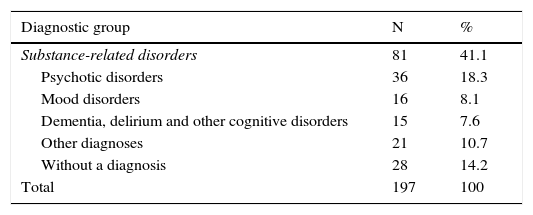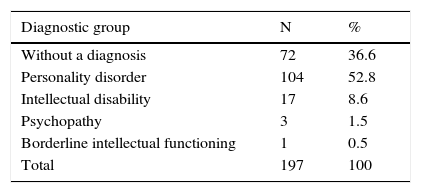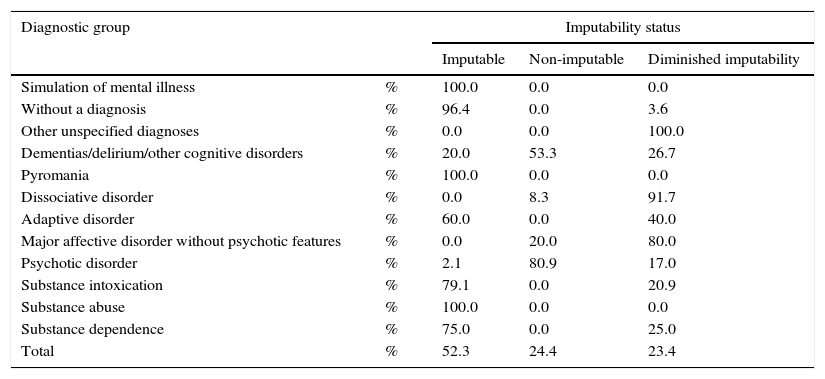The purpose of the study is to describe arsonists in their demographic, psychiatric and criminological dimensions and to explore factors associated with the expert opinion of insanity.
Material and methodsA series of cases accused of arson and assessed in the adult Psychiatric Unit of the Legal Medical Service of Chile, during the period 1999–2012 (N=197) is described. With a cases and controls design, the factors associated with the opinion of insanity are explored.
ResultsThe series of cases had a high prevalence of mental disorders, social and family problems. Expert opinion compatible with the condition of criminal responsibility was achieved in 52.3% of the cases; and in 24.4% it was compatible with insanity and in 23.3% with diminished criminal responsibility.
ConclusionsThe conditions of insanity and diminished criminal responsibility, grouped together as “expert opinion of altered criminal responsibility” were significantly associated with bizarre behaviour, pathological motivation, emotional motivation, self-harm and cooperative attitude of the accused.
Los objetivos del estudio son describir a acusados del delito de incendio en las dimensiones demográfica, psiquiátrica y criminológica y explorar factores asociados a la opinión pericial de inimputabilidad.
Material y métodosSe describe la serie de casos acusados de incendio y evaluados pericialmente (N=197) en la Unidad de Psiquiatría de Adultos del Servicio Médico Legal de Chile, durante el periodo 1999-2012 y con diseño de casos y controles se exploran factores asociados con la opinión de inimputabilidad.
ResultadosLa serie de casos tuvo alta prevalencia de problemas sociales, familiares y de trastornos mentales. En el 52,3% se alcanzó conclusión pericial compatible con la imputabilidad, en el 24,4% con la inimputabilidad y en el 23,3% con la imputabilidad disminuida.
ConclusionesLas condiciones de inimputabilidad e imputabilidad disminuidas, agrupadas como «opinión pericial de imputabilidad comprometida» se asociaron significativamente a la verificación de conducta bizarra, motivación patológica, motivación afectiva, autolesiones y actitud colaboradora del acusado.
Previous studies have shown that those who set fires have diverse motivations1,2 and a high prevalence of various mental disorders, mainly substance use disorders, psychosis, personality disorders and intellectual disability.3–15 The clinical diagnosis of “pyromania” has been questioned in regard to its theoretical validity and utility for forensic investigation as it does not correspond with the majority of arsonists.16,17 It has also been reported that in this population, personality disorders are one of the most common psychiatric diagnoses.18–20 Research on psychopathy in the arsonist population add no particularities in relation to this type of subject other than those described in psychopathy in general.21,22
Other authors report that it is common here to find socioeconomic problems and relational difficulties,23,24 and they relate arsonists’ behaviour to psychological, emotional, mood-related and sexual factors, lack of impulse control, substance use, suicidal intentions and economic interests.25–27
Although Ganon22 indicates that women constitute a little-studied group, at the same time, other authors observe an absolute and relative increase of up to 38% of the total in populations of arsonists.28,29 Some studies of women arsonists report that the frequency of psychiatric diagnoses was higher than among men, with prevalences ranging from 42% to 92%, and also that women had a high frequency of suicidal behaviour.30,31 Other studies report that female arsonists report a history of significant abuse and deprivation in childhood, and this is similar to that found in non-arsonist women offenders.32–35 Bourget,20 by contrast, observed that women arsonists, when compared with female non-offenders, would be more likely to be single or separated.
Among these contributions, none comes from Latin American studies; from Chile, there is one descriptive study (Koppmann et al.).12 In other words, we know little about local arsonists, which disorders they have, what motivations lead them to set fires, and how they compare and contrast with arsonists in other countries, even though such information would presumably be relevant as input for public policies and primary and secondary prevention plans.
To contribute to filling in these gaps in information, this article describes a series of cases of arsonists studied in Chile's Legal Medical Service, over a period of 13 years, considering their demographic, clinical and criminological dimensions. It also explores the relationship between these variables and the expert opinion compatible with non-imputability.
Material and methodsA quantitative design was employed, consisting of a descriptive section of case series and another analytical section with a design of “cases and controls”. The cases were defined by the dependent variable “expert opinion compatible with non-imputability”. Given that Articles 10 and 11 of the Chilean Penal Code36 stipulate two conditions for establishing criminal responsibility, namely, non-imputability and diminished imputability, for the final analysis, both variants of establishing imputability have been subsumed in the dependent variable “expert opinion compatible with implicated imputability”. The alternative hypothesis was formulated as follows: demographic, psychiatric and criminological factors are associated differently with the condition of being an arsonist, with “expert opinion compatible with implicated imputability” than with that of being an arsonist but with “expert opinion compatible with imputability”.
The information was obtained from 197 psychiatric reports corresponding to the total number of individuals charged with the crime of arson and examined in the Adult Psychiatry Unit of Chile's Legal Medical Service during the period 1999–2012.37 Although the information on the cases tried is public, the procedure was authorised by the Legal Medical Service's management, with the stipulation that the names in the cases be kept confidential.
For the diagnoses, the DSM IV-TR (APA, 2003) was used and the related nosological diagnoses were added in syndromic types. The arsonists’ motivations were categorised and defined operatively as follows: affective (associated with feelings and non-pathological passional and emotional states), psychopathological (explained by any axis I disorder, including pyromania); reckless (derived from unintentional and careless behaviour), criminal (related to calculated and planned criminal intent, whether the fire-setting was part of the main objective or only a means by which to commit another crime), ideological/political/religious (justified by a specific world-view of a given organisation to which the perpetrator belongs). Although the act of categorising these behaviours is difficult and imperfect owing to the possible combination of motivations, in terms of mental health and behavioural sciences, the approach is useful.
The data obtained were arranged in tables showing the frequency distribution and association of variables, and SPSS 15.0 was used for the statistical analysis. Chi-squared and logistic regression models were constructed, and the results from the multivariate testing were presented.
ResultsThe average age in the series was 39 (SD=13). The ratio of men to women was 4 to 1, and between the sexes there were no significant differences in any sociodemographic, psychiatric or imputability-related variables. In all, 64.5% did not have a spouse or partner and 85% lacked vocational or professional training when they set the fires, and 1.5% had a criminal history of fire-setting.
Most had some type of psychiatric diagnosis that fell within axis I of DSM IV-TR, and the disorders related to substance use, which were the most common syndromic diagnosis, were broken down as follows: 32.3%, intoxication by alcohol; 4.8%, others due to alcohol abuse; 4%, abuse of other substances. The frequency for diagnosis of pyromania was much lower (Table 1).
Distribution of psychiatric diagnostic groups.
| Diagnostic group | N | % |
|---|---|---|
| Substance-related disorders | 81 | 41.1 |
| Psychotic disorders | 36 | 18.3 |
| Mood disorders | 16 | 8.1 |
| Dementia, delirium and other cognitive disorders | 15 | 7.6 |
| Other diagnoses | 21 | 10.7 |
| Without a diagnosis | 28 | 14.2 |
| Total | 197 | 100 |
Diagnostic categories in axis I DSM IV-TR. Substance-related disorders include codes 303.90, 305.00, 303.00, 292.89, 304.20, 305.60, 292.89 and 305.20; psychotic disorders include codes 295.30, 295.10, 295.20, 295.90, 205.60, 295.70, 297.1, 298.8, 296.34, 296.44, 296.64, 291.5, 291.3, 292.11 and 292.12; mood disorders include codes 296.33 and 311; dementia, delirium and other cognitive disorders include codes 191.0, 291.2, 291.1, 291.0, 294.1 x and 294.8 and 780.09; and other diagnoses include codes 300.6, 300.15, 309.3, 309.4, 309.9, 312.33 and V65.2.
The presence of axis II disorders as per the DSM IV-TR was also verified in a large proportion. All personality disorders were grouped together, except for the avoidant type, since no case was investigated. Psychopathy was set aside, and for a diagnosis of which the expert evaluator used the Hare38 criteria, showing a low frequency (Table 2).
Distribution of psychiatric diagnostic groups.
| Diagnostic group | N | % |
|---|---|---|
| Without a diagnosis | 72 | 36.6 |
| Personality disorder | 104 | 52.8 |
| Intellectual disability | 17 | 8.6 |
| Psychopathy | 3 | 1.5 |
| Borderline intellectual functioning | 1 | 0.5 |
| Total | 197 | 100 |
Diagnostic categories in axis II DSM IV-TR (includes codes 301.0, 301.20, 301.22, 301.7, 301.83, 301.50, 301.81, 301.6, 310.4 and 301.9) and indication of psychopathy according to the Hare Psychopathy Checklist-Revised.
Almost half of the population studied showed some degree of imputability, and consequently, criminal responsibility (Table 3).
Psychiatric diagnoses of axis I DSM IV-TR and expert opinion.
| Diagnostic group | Imputability status | |||
|---|---|---|---|---|
| Imputable | Non-imputable | Diminished imputability | ||
| Simulation of mental illness | % | 100.0 | 0.0 | 0.0 |
| Without a diagnosis | % | 96.4 | 0.0 | 3.6 |
| Other unspecified diagnoses | % | 0.0 | 0.0 | 100.0 |
| Dementias/delirium/other cognitive disorders | % | 20.0 | 53.3 | 26.7 |
| Pyromania | % | 100.0 | 0.0 | 0.0 |
| Dissociative disorder | % | 0.0 | 8.3 | 91.7 |
| Adaptive disorder | % | 60.0 | 0.0 | 40.0 |
| Major affective disorder without psychotic features | % | 0.0 | 20.0 | 80.0 |
| Psychotic disorder | % | 2.1 | 80.9 | 17.0 |
| Substance intoxication | % | 79.1 | 0.0 | 20.9 |
| Substance abuse | % | 100.0 | 0.0 | 0.0 |
| Substance dependence | % | 75.0 | 0.0 | 25.0 |
| Total | % | 52.3 | 24.4 | 23.4 |
In terms of motivation to set fires, those of an affective and psychopathological nature were salient (Fig. 1).
In most cases, the arsonist acted alone and burned down their own house, with the act of setting fire to a second or third dwelling being uncommon. The intent to commit arson was present in most cases, although the proportion of cases involving premeditation was much lower. After the fire-setting, the most common case was non-cooperation with the authorities, while the remaining cases were divided between bizarre or cooperative behaviour. The consequences of the fire from a criminal point of view were property-related damages, followed by injuries and deaths, which were far less common.
Five independent criminological variables and one legal/criminal variable were significantly associated with having “expert opinion compatible with implicated imputability” (Table 4).
Logistic regression model with dependent variable: compatible with implicated imputability.
| Independent variables | B | SD | Wald | df | p | OR | 95% CI for EXP(B) | |
|---|---|---|---|---|---|---|---|---|
| Lower | Upper | |||||||
| Bizarre behaviour | 4.2 | 1.2 | 12.9 | 1 | <0.001 | 67.5 | 6.8 | 669.9 |
| Pathological motivation | 4 | 0.8 | 24.7 | 1 | <0.001 | 57.2 | 11.6 | 281.7 |
| Affective motivation | 2.2 | 0.6 | 13.9 | 1 | <0.001 | 8.6 | 2.8 | 26.6 |
| Self-harm | 2.9 | 1.1 | 6.5 | 1 | 0.011 | 18.5 | 2 | 176.8 |
| Damages | -2.3 | 1.1 | 4.1 | 1 | 0.042 | 0.1 | 0.01 | 0.9 |
| Cooperation | 1.7 | 0.5 | 10.9 | 1 | 0.001 | 5.3 | 2 | 14.5 |
SD: standard deviation; df: degrees of freedom; OR: odds ratio.
The objective of this study was to describe a series of judicial cases in which individuals were accused of arson and evaluated psychiatrically during the judicial process in Chile. Although the findings suggest that this arsonist population has diverse characteristics that preclude the establishment of a single profile, they also allow us to discuss a number of relevant regularities.
Worthy of note among the findings is the high prevalence of social and family-related problems and mental disorders, consistent with reports from other populations (Enayati et al.).29 Particularly striking was the high prevalence of drinking problems. Alcohol, besides potentially facilitating violent behaviour, is an indicator of various vulnerabilities, as alcohol consumption is often associated with situations involving conflict, stress and despair. Although the condition of being intoxicated during the act does not have a direct bearing on non-imputability, which in this study was diagnosed in one-third of the arsonists and indicates extreme situations and possible disinhibition, it is considered a relevant factor for understanding the phenomenon. It is therefore an element that should not be neglected during an expert study.
This arsonist population does not demonstrate the predominant antisocial characterisation that is usually seen in Latin America's prison population.39–41 In addition to confirming a much lower rate of psychopathy than in the general prison population, it should be noted that in less than one-tenth of the series were experts able to determine the criminal motivation; i.e., one related to calculated and planned criminal intent, whether the fire-setting was part of the main objective or merely a means for committing another crime. With this in mind, one could expect to find a preponderant attitude of cooperation with the authorities. However, the finding is far from what could be expected, as almost half of the arsonists did not cooperate. The interpretation of the finding is that, on one hand, even in subjects with antisocial personality traits, it is possible to verify that fire-setting behaviour may be associated with affective or psychopathological motivations and not necessarily with the criminal type. The alternative may be helpful for the police investigating this type of crime, since it facilitates a multi-directional search for the motive and helps to cast a greater light on the criminal dynamics. On the other hand, the finding reveals that evasive behaviour with regard to responsibility, such as running away, concealing information or creating an alibi, can be verified in various types of arsonists, even in those who have no antisocial personality disorder and who, moreover, may have disorders which compromise imputability.
One of the main contributions of the study makes is the characterisation of the vast majority of fire-setting acts as self-destructive. Fire-related damages occurred in particular to the arsonists’ own properties, which involves monetary damages and adverse consequences for the arsonists’ health and well-being and those of the cohabitants. The very common intent to commit arson detected was not accompanied by premeditation, and what is more, it responded to affective, psychopathological and reckless motivations. All these markers in the behavioural sequence would seem to suggest a predominantly reactive dynamics. Confirmation of pyromania was consistently the exception. In general, the findings make it possible to establish a profile for the arsonists in central Chile which is somewhat different from what often appears in the yellow press regarding psychopaths or pyromaniacs who are serial arsonists. On the contrary, the most representative profile is that of a person with various vulnerability-related factors, including the psychopathological factor, located in a conflictive context of personal type and/or the surrounding environment.
Another noteworthy finding is the large number of subjects who lacked full awareness, judgement or intent upon setting the fire, and on whom the experts’ studies reached conclusions compatible with implicated imputability. This finding contrasts sharply with previous Latin American studies that reported non-imputability figures among those accused in general of 0.2%42 and in sexual abusers of 1%,43 and comes close only to what has been reported for homicides.44 In accordance with the results of this study, among those who are prosecuted for arson, the likelihood of mental disorder is high, and there is some degree of impairment in the degree of judgement and intent that justice requires in order to hold a person responsible for a crime. Both findings provide valuable information for the justice system and mental health services. While in the former area, vulnerabilities and their impact on imputability should be the focus of close scrutiny when judging one accused of arson, in the field of mental health, the risk that individuals with a psychopathological disorder and/or experiencing conflict situations may set fires should receive careful consideration. As for the specific expert activity in evaluating and advising with regard to mental state at the time, the findings from this study in the logistic regression model are also informative. Here it should be noted that, although an association between bizarre behaviour and pathological motivation with the opinion of implicated imputability was expected, the significant association with affective motivation, self-harm and cooperative attitude is an empirical contribution.
The study is limited insofar as the case series was restricted to the centre of the country and is not representative of other regions, such as VIII and IX, where intentional fires are a common problem. This allows for important heuristics inasmuch as these present findings may be compared with new studies in the south of the country.
Conflicts of interestThe authors declare that there are no conflicts of interest.
Please cite this article as: Dresdner Cid R, Folino JO. Trastornos mentales y responsabilidad criminal en incendiarios. Rev Esp Med Legal. 2017;43:58–63.










